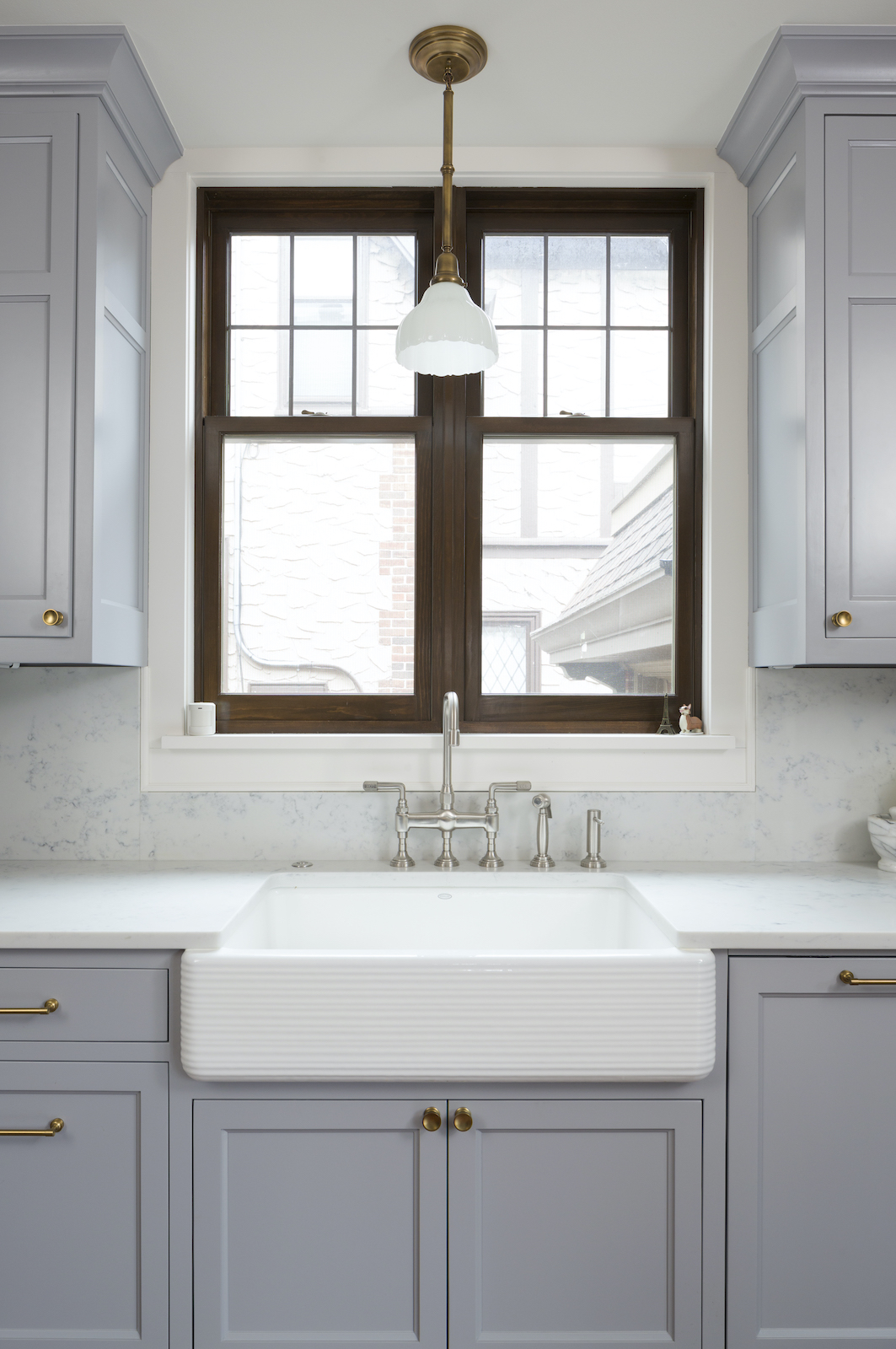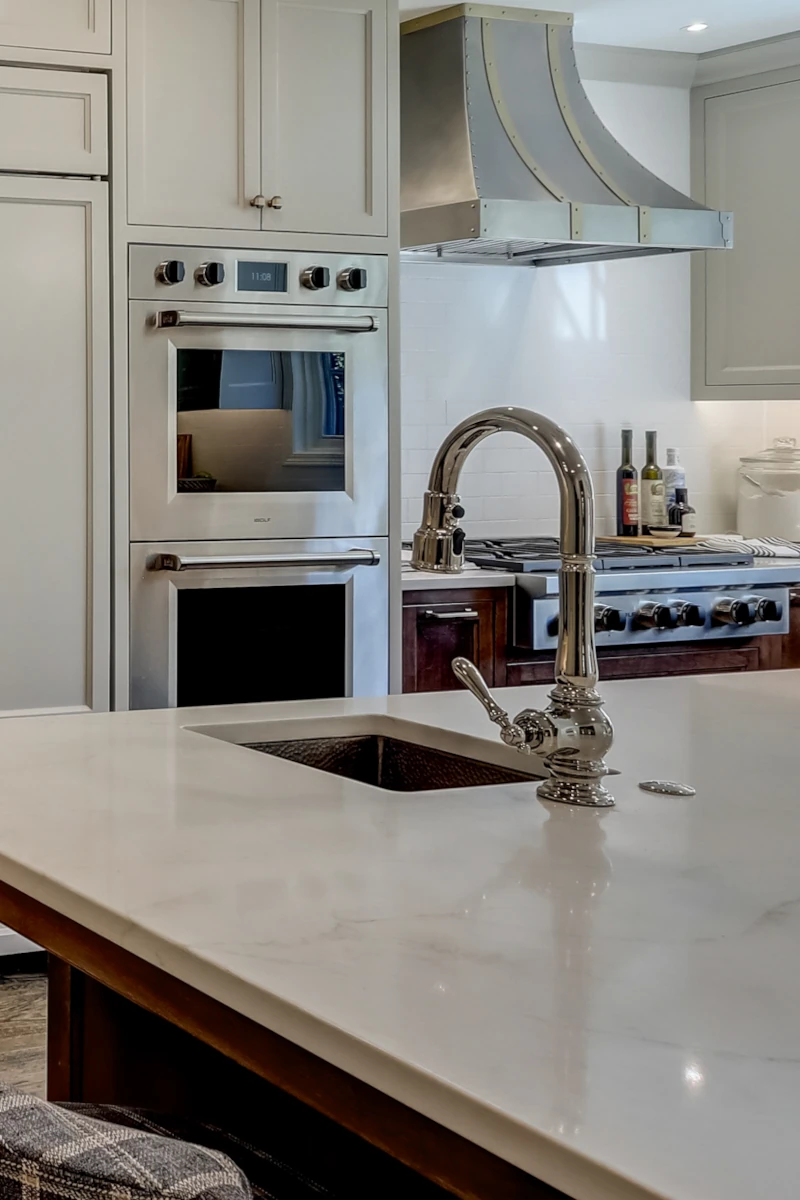During kitchen remodeling, the sink isn’t just part of the kitchen work triangle—It’s an essential element of design and style. We hope this guide to kitchen sinks will help enhance your home.
When selecting a kitchen sink, our home remodeling clients often consider the unit’s aesthetic, budget, depth, number of compartments, material, and optional accessories.
After reviewing this article, talk with your builder and interior designer about which sink will work best for your space.
Many of the major brands are available at your local plumbing supply house, so you can try the sink before you purchase it for your remodeling project.
Guide to Kitchen Sinks: Sink Styles
Top Mount Sink
The top mount sink, also known as a drop-in sink, is the most common sink in the United States. As the name implies, these sinks are installed from the top. The sink manufacturer will provide a paper template in the box for the remodeling company to cut an appropriate hole in the countertop. The sink is secured by a sealant or plumber’s putty, along with steel clips.
See also: Our post on 10 Different Types of Countertops for your Kitchen Remodel.
Pros
- Many budget-friendly options.
- Fabrication of the opening can be done at the construction site.
- The sink opening does not have to be perfect.
- DIY friendly.
Cons
- The rim can collect debris and bacteria, making it harder to clean.
- Considered by some to by an eyesore.
- Unable to sweep items from the countertop into the sink.
- Faucet must be mounted in specific holes.
Undermount Sink
Most commonly paired with solid-surface countertops, undermount sinks are fastened to the underside of the countertop using adhesive and clips and are the most common sinks we see in our kitchen remodels. Undermount sinks are available in many different materials and configurations.
Pros
- Considered by most to be superior in appearance to top mount sinks.
- More quality options when compared to top mount sinks.
- The lack of a rim allows you to sweep water and debris into an undermount sink.
Cons
- Discoloration and grime can build up in the area between the countertop and the lip of the sink.
- Can be more costly than their value-oriented, top-mount relatives.
Apron Sink

Often referred to as farmhouse sinks, apron sinks gained popularity in the late 17th century in England where they were found in butler’s pantries. The sink was mounted further forward to reduce strain on rural users and staff before the widespread availability of running water. These somewhat forgotten sinks would gain popularity again in the United States in 2014, when HGTV influencers popularized Americans turning their home into a farmhouse. Although this fad has passed, some of our remodeling clients who want a French-styled kitchen choose an apron sink.
Pros
- The sink itself forms the front of the cabinet, which is less susceptible to damage than other materials.
- The edge of the sink is closer to the user.
Cons
- Cabinets need to be modified for installation.
- Considered out of style or dated in many applications.
- Future remodeling will likely require replacing the cabinets.
Integrated Sink
An integrated sink is most commonly a sink and a countertop in one piece, with a single material. Integrated sinks provide a seamless aesthetic and a feel of additional luxury within a home. In some models, the sink is made of stainless steel or other solid surface materials.
Historically, integrated sinks were available from manufactures like DuPont in their Corian line, but now even brands like Formica offer integrated options.
We most often see integrated sinks in laundry rooms or basements where clients have selected a less expensive or more durable countertop material, but the kitchen is becoming a more popular choice with many homeowners.
Pros
- Considered better looking in an application that would traditionally have a surface mount sink.
- More hygienic because there is no rim for bacteria to accumulate.
- Easier to clean.
Cons
- More expensive than top-mount sinks.
- Only available with certain types of countertops.
- Limited sink options.
Prep Sink
A prep sink—also known as a bar sink—is generally a secondary sink that is smaller than a traditional kitchen sink.
Interior designers often specify these sinks on a kitchen island, in a butler’s pantry, or for a wet bar.
Our remodeling clients often use them for food preparation, storing drinks on ice for a party, or as a hand-washing sink.
These sinks can come in unique shapes such as round, square, or rectilinear and are almost always single basin.
Sink Materials
When choosing the right material for your kitchen sink, consider how it will be used. If your family accumulates a lot of dishes, you’ll need a deeper basin. If you maintain a busy lifestyle, you may not have the time to properly maintain a special surface. A kitchen sink should always be durable and able to withstand deep cleaning. However, it is also important to consider a material that complements the style of your kitchen. Following is a summary of different materials.
Stainless Steel Sinks
The most popular material, stainless steel is available in a wide variety of styles, including drop-in, farmhouse, and undermount.
Its cost, durability and ease of cleaning make it the most common choice. To prevent dents and scratches, choose a higher-gauge stainless steel—18- to 16-gauge. The lower the number, the thicker the material.
To hide water spots and scratches, choose a brushed satin finish.
To reduce the sound of water hitting the bottom of the sink, choose a model with vibration-damping foam insulation or pads on the underside of the bowls.
Granite Quartz Composite Sinks
Available in drop-in, farmhouse and undermount styles, granite quartz composite sinks are a mixture of 80 percent quartz and 20 percent resin.
This sturdy, low-maintenance surface resists scratches, stains, and heat. Available in a range of colors, it can withstand hot cookware.
Fireclay Sinks
As its name suggests, fireclay sinks are a hard-fired, clay material. Similar in appearance to cast iron, it’s mainly used in farmhouse-style sinks.
With a smooth, glazed, non-porous surface, fireclay is an extremely durable material. It resists chips, scratches, and acid damage. We like fireclay sinks from Shaws, a company founded in England in 1897, whose sinks are still in use in 100-year-old English homes.
It is primarily sold in white, but a variety of colors and textures are available.
Cast Iron Sinks
This type of sink is made of cast iron and coated in porcelain enamel to provide a hard, durable surface. Its smooth, glass-like finish is easy to clean, and cast iron is guaranteed not to chip, crack or burn.
In Southeastern Wisconsin, we are fortunate to be near Sheboygan County-based Kohler, an elite manufacturer of cast iron and other kitchen sinks.
Cast iron’s downside is its weight. Upwards of 125 pounds, a cast-iron sink requires two people to install. It is not typically suited for wall-mount installation.
Copper Sinks
Copper is a highly durable metal that does not rust or tarnish. It also requires little maintenance.
Copper’s anti-microbial properties kill bacteria and viruses. Due to oxidation over time, the copper surface gradually takes on an aged patina, which acts as a protective coating.
Each copper sink is individually handcrafted and unique, which provides extra distinction in your kitchen.
Getting the Perfect Kitchen Sink
Picking the right kitchen sink for your home remodeling project can be difficult. There are millions of options from hundreds of manufactures. Finding a qualified builder and an interior designer who understands your family’s needs will help you narrow your search down to the perfect sink. When you’re ready to start your kitchen remodeling process, please contact us at LaBonte Construction.


